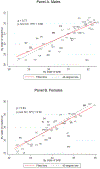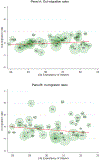Understanding Geographic Disparities in Mortality
- PMID: 36912599
- PMCID: PMC10229145
- DOI: 10.1215/00703370-10609710
Understanding Geographic Disparities in Mortality
Abstract
A rich literature shows that early-life conditions shape later-life outcomes, including health and migration events. However, analyses of geographic disparities in mortality outcomes focus almost exclusively on contemporaneously measured geographic place (e.g., state of residence at death), thereby potentially conflating the role of early-life conditions, migration patterns, and effects of destinations. We employ the newly available Mortality Disparities in American Communities data set, which links respondents in the 2008 American Community Survey to official death records, and estimate consequential differences based on the method of aggregation we use: the unweighted mean absolute deviation of the difference in life expectancy at age 50 measured by state of birth versus state of residence is 0.58 years for men and 0.40 years for women. These differences are also spatially clustered, and we show that regional inequality in life expectancy is higher based on life expectancies by state of birth, implying that interstate migration mitigates baseline geographic inequality in mortality outcomes. Finally, we assess how state-specific features of in-migration, out-migration, and nonmigration together shape measures of mortality disparities by state (of residence), further demonstrating the difficulty of clearly interpreting these widely used measures.
Keywords: Geographic disparities; Migration; Mortality; Place of birth.
Copyright © 2023 The Authors.
Figures







References
-
- Boustan LP, Kahn ME, Rhode PW, & Yanguas ML (2020). The effect of natural disasters on economic activity in US counties: A century of data. Journal of Urban Economics, 118, 103257.
-
- Chiang CL (1984). The life table and its applications (pp. 193–218). Malabar, FL: Krieger.
Publication types
MeSH terms
Grants and funding
LinkOut - more resources
Full Text Sources
